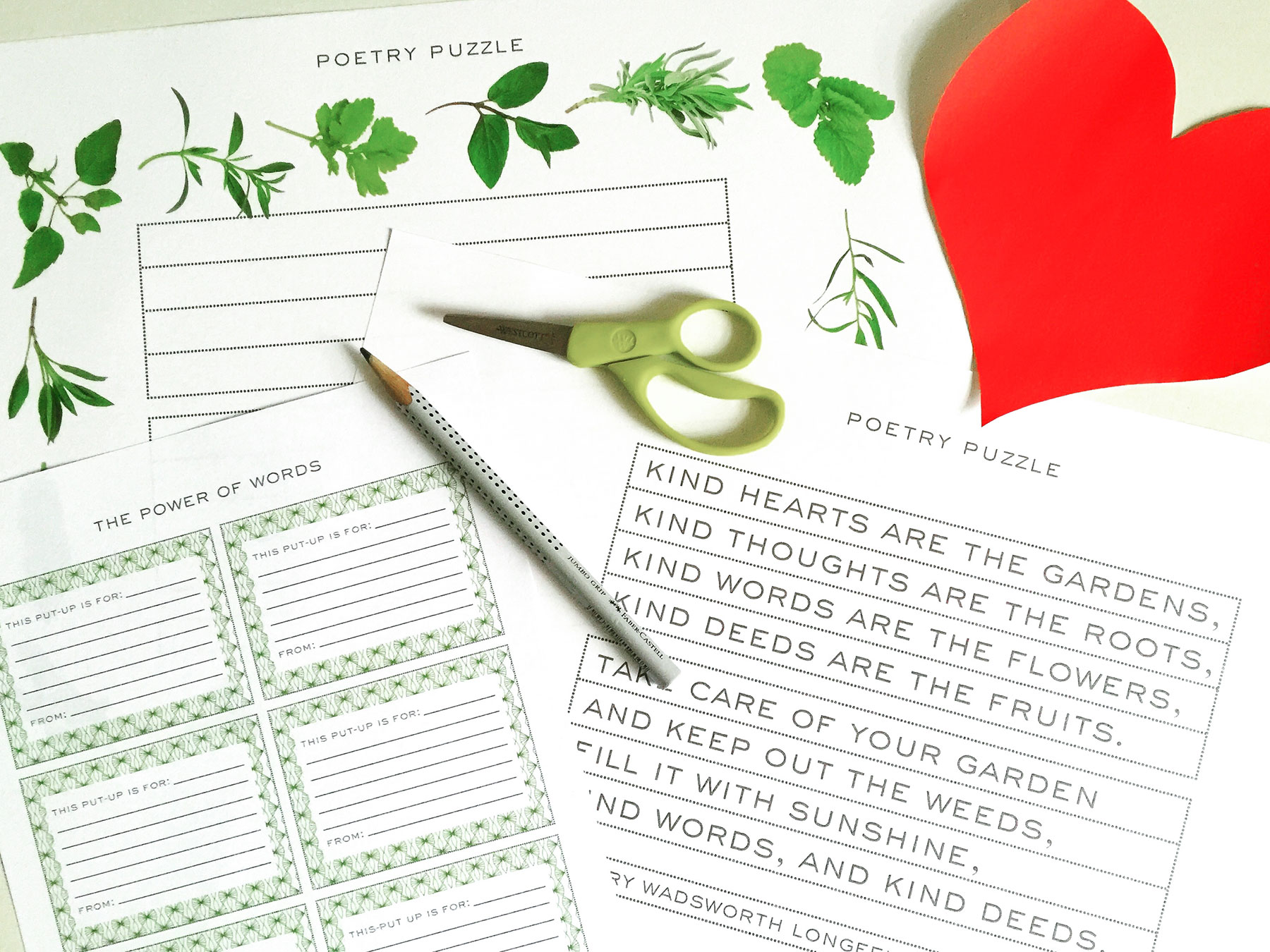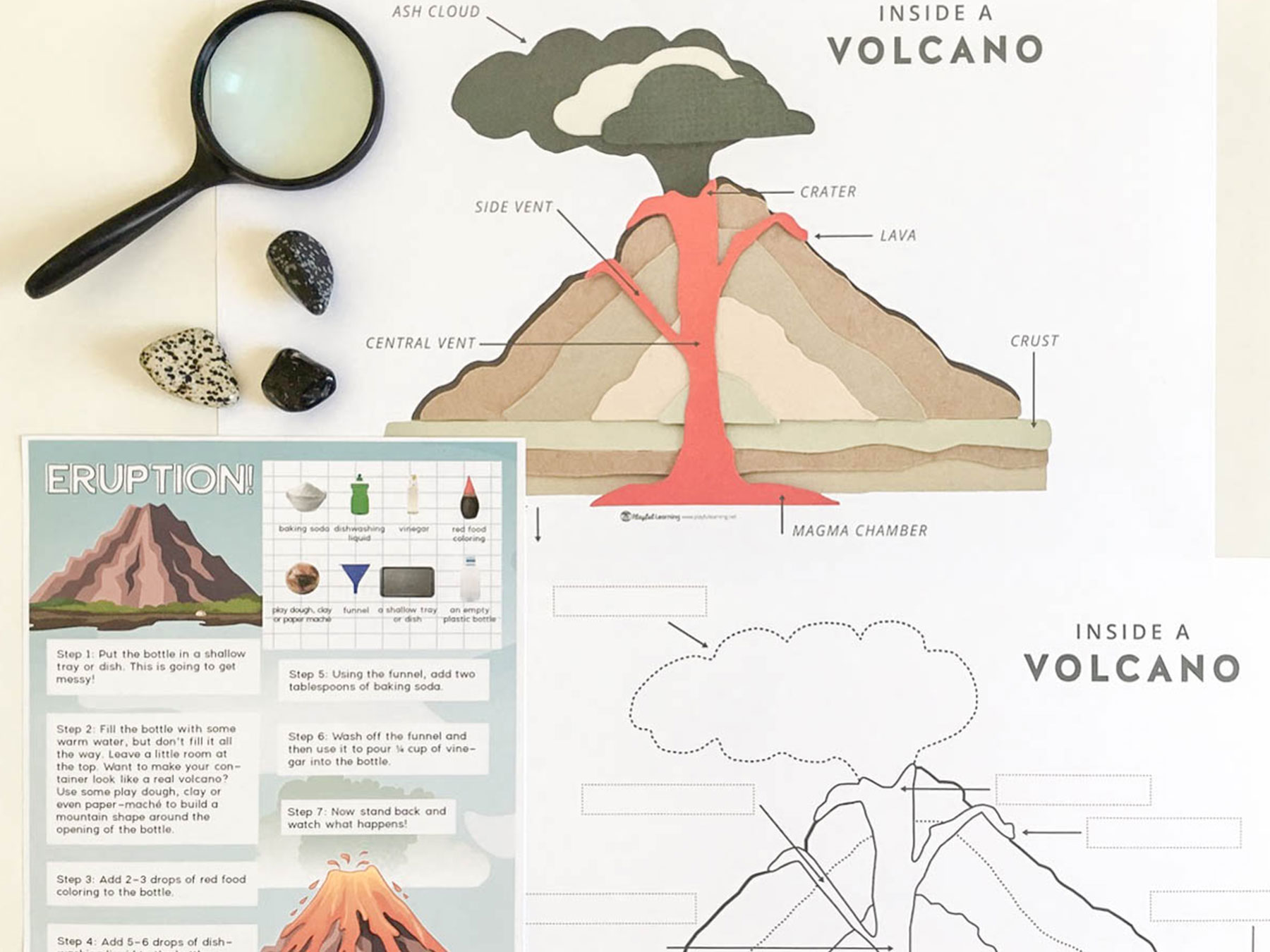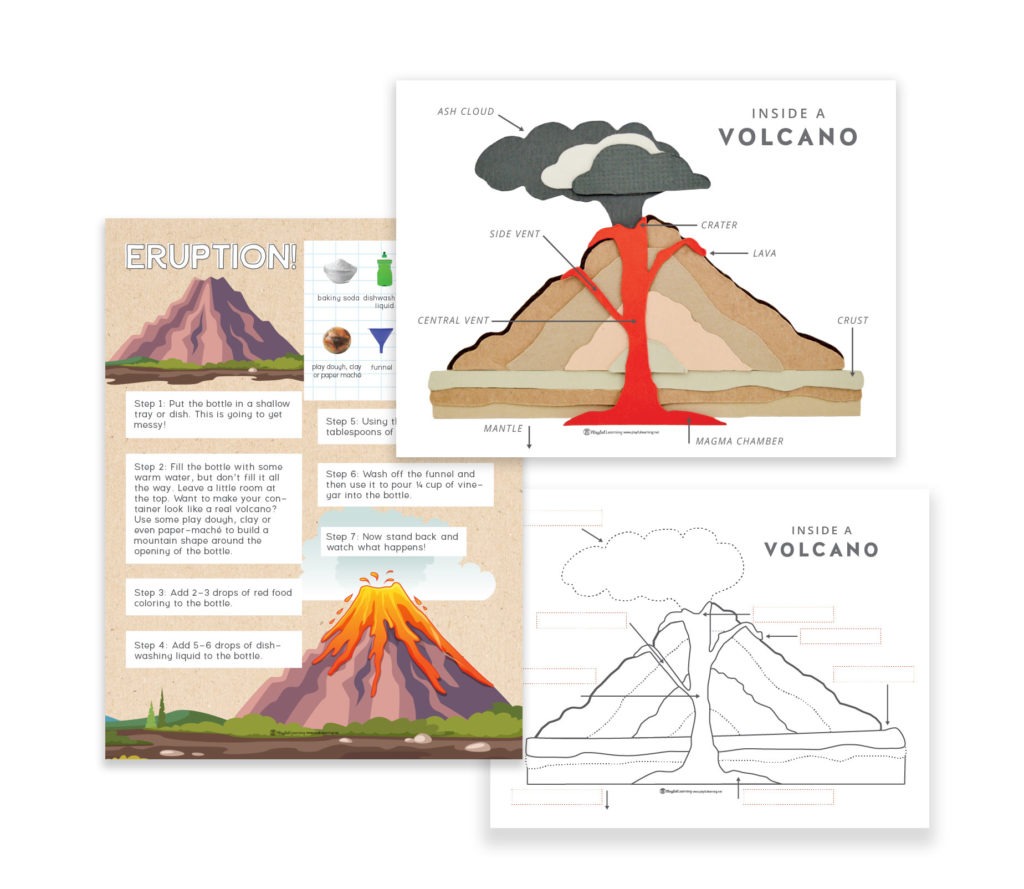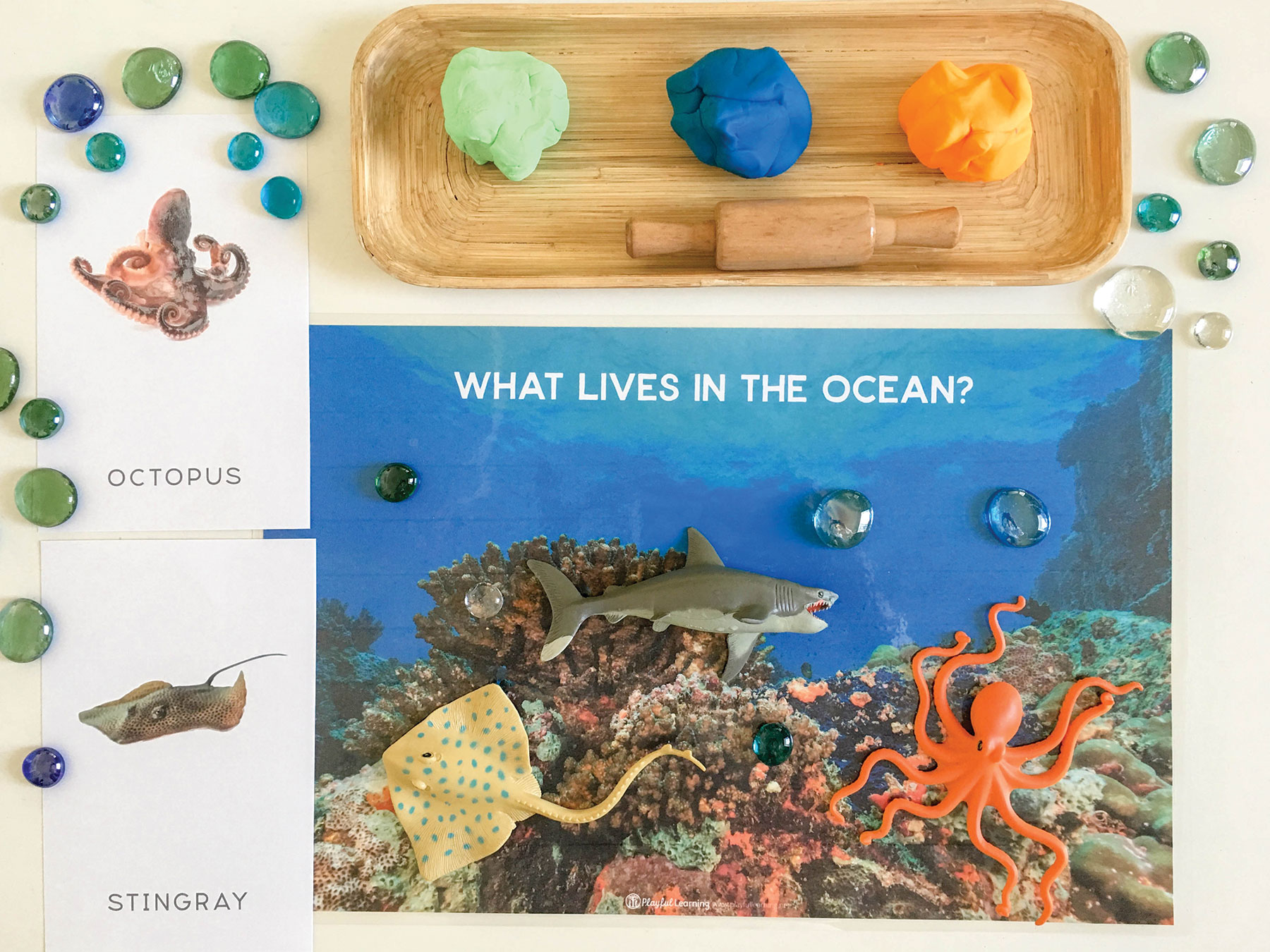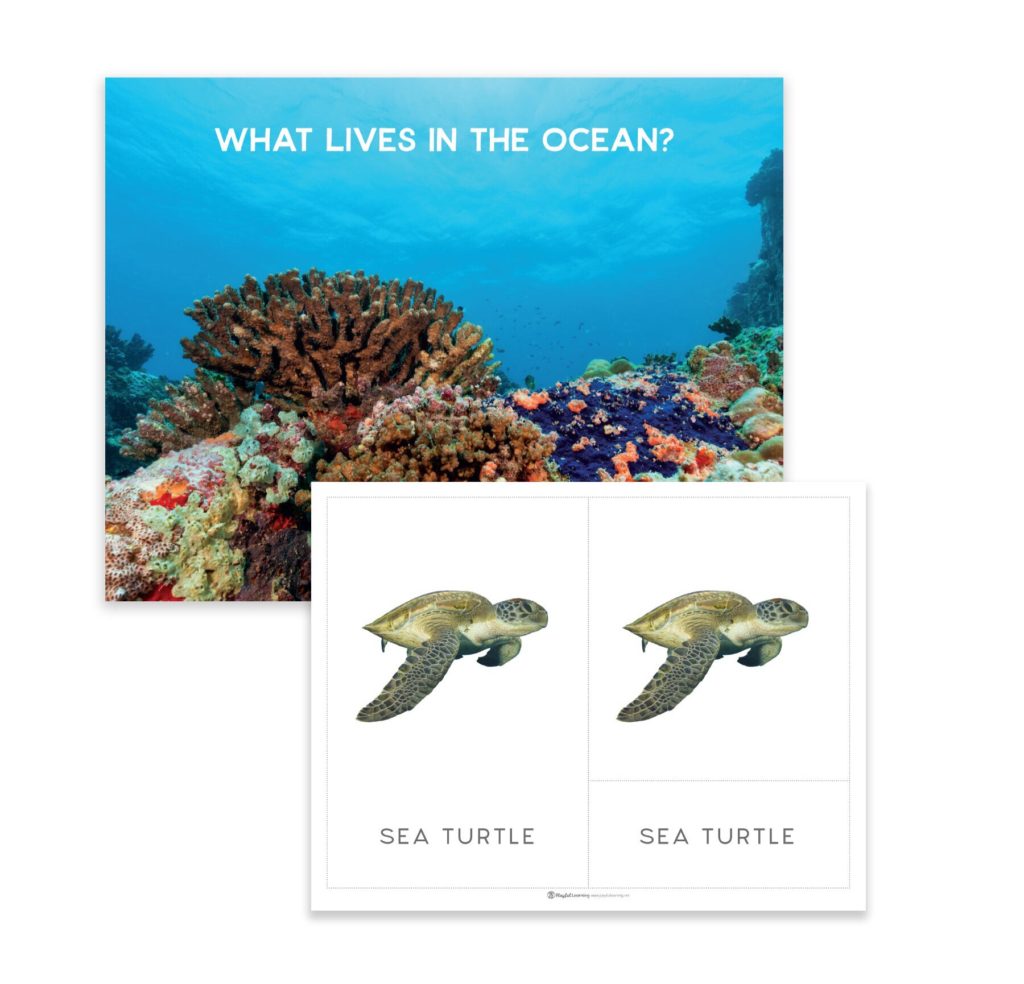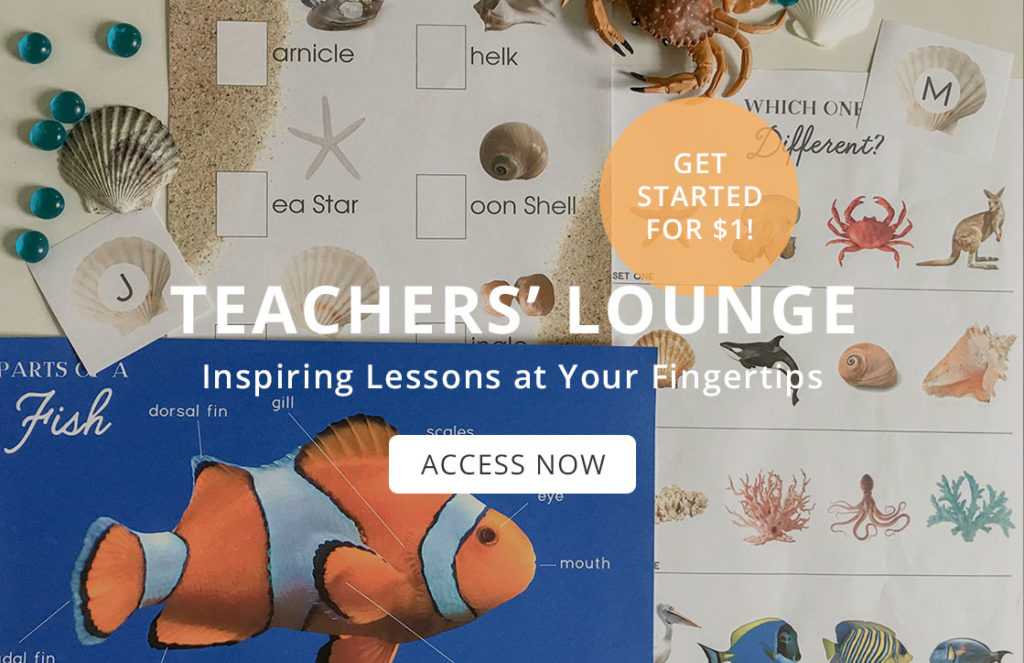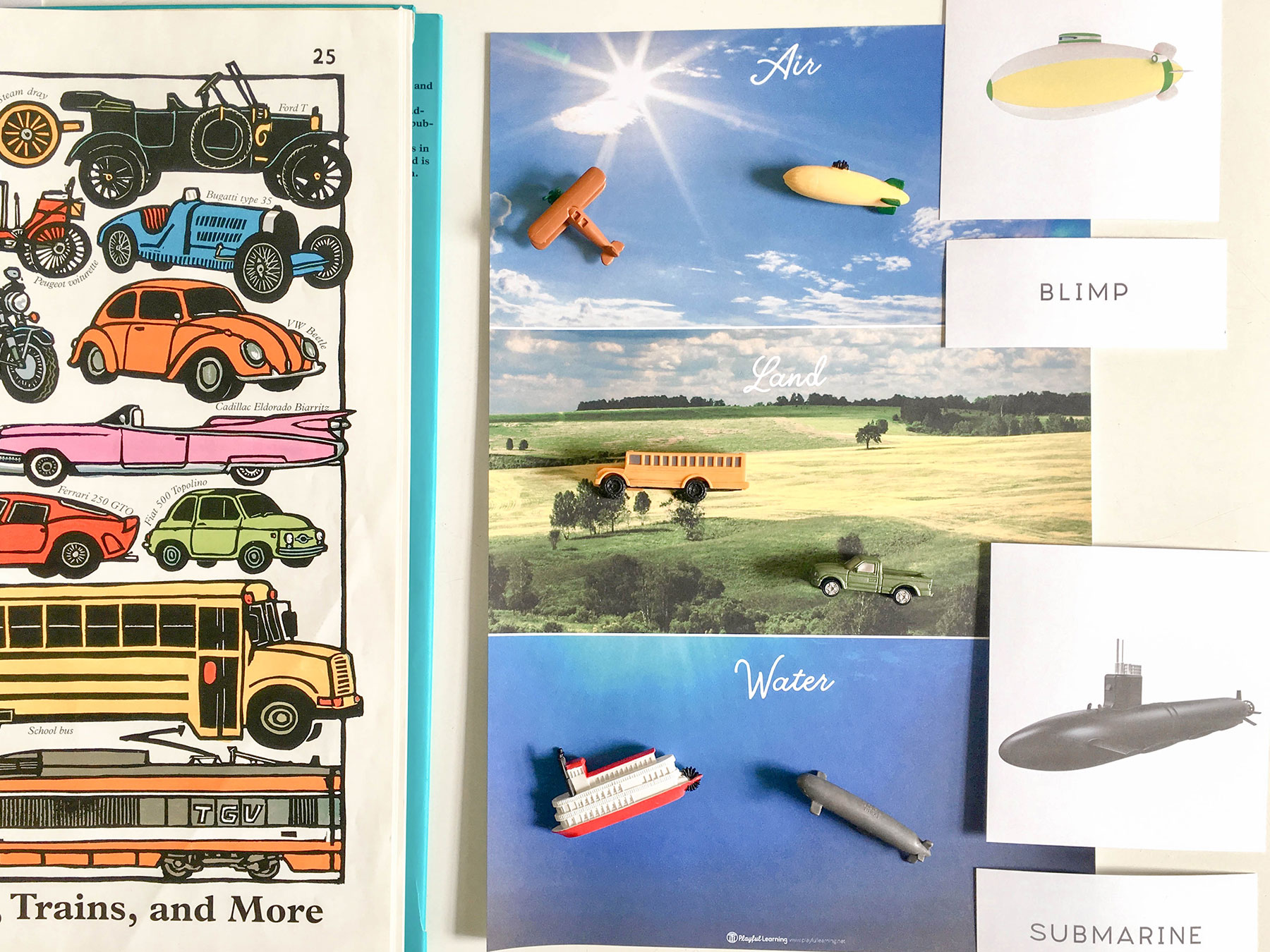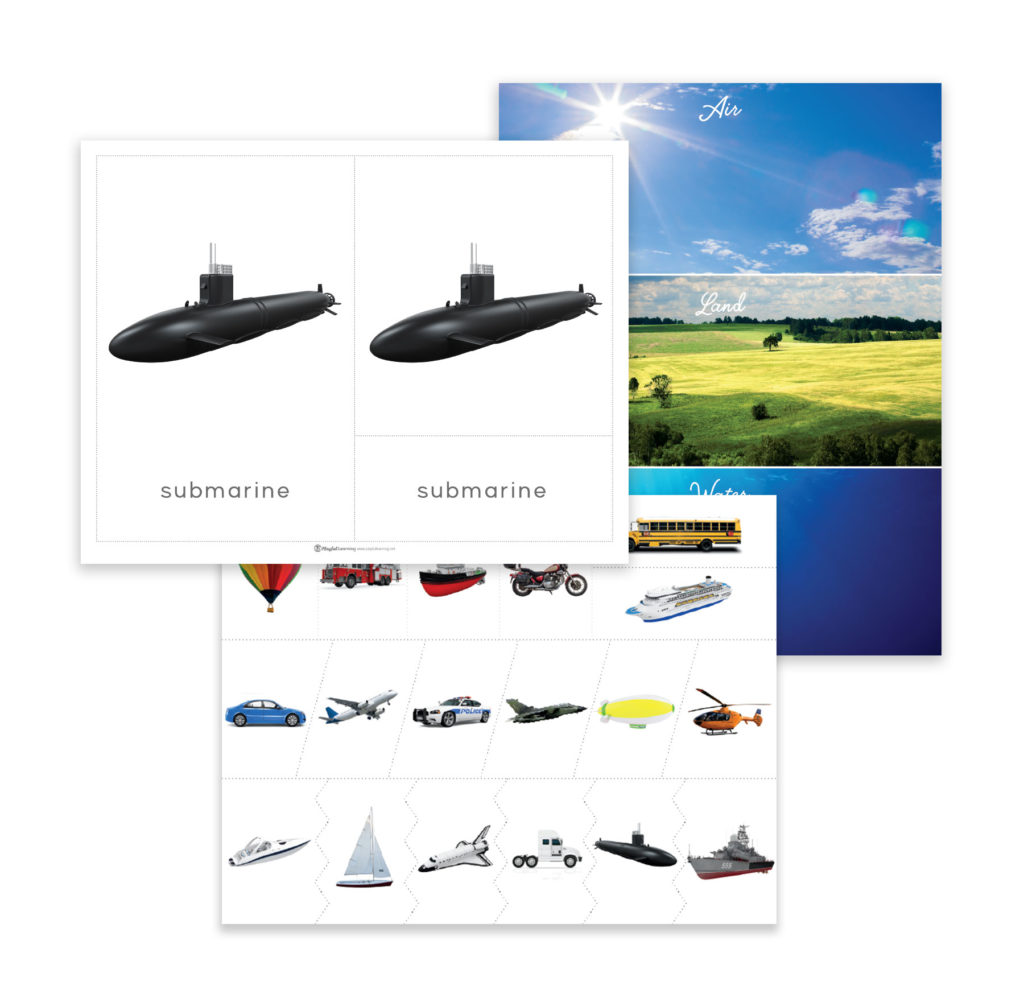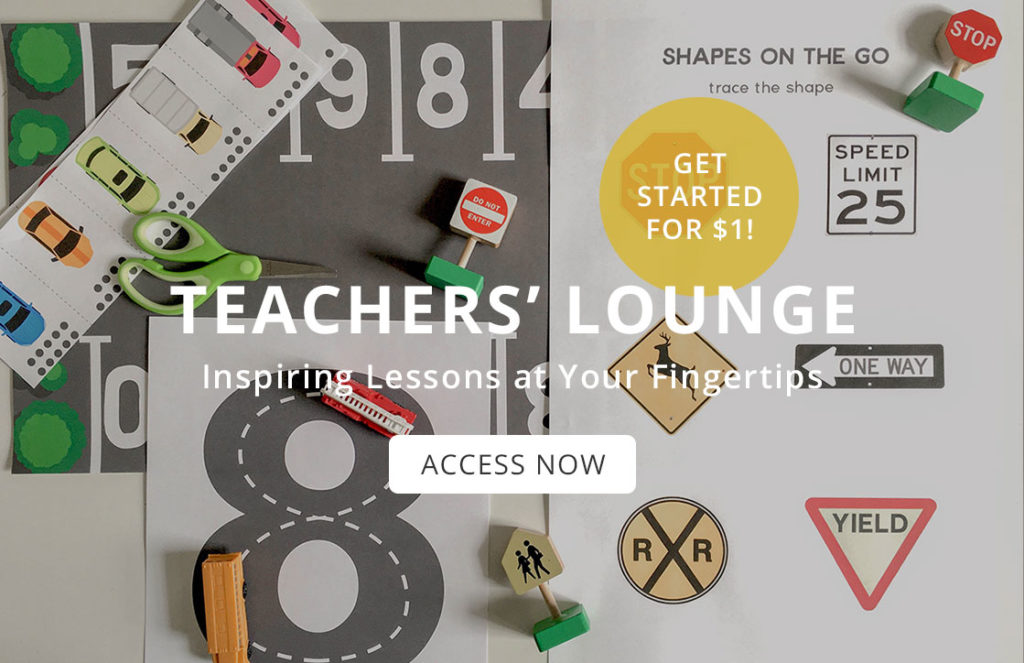Early Literacy: Short Vowel Sort
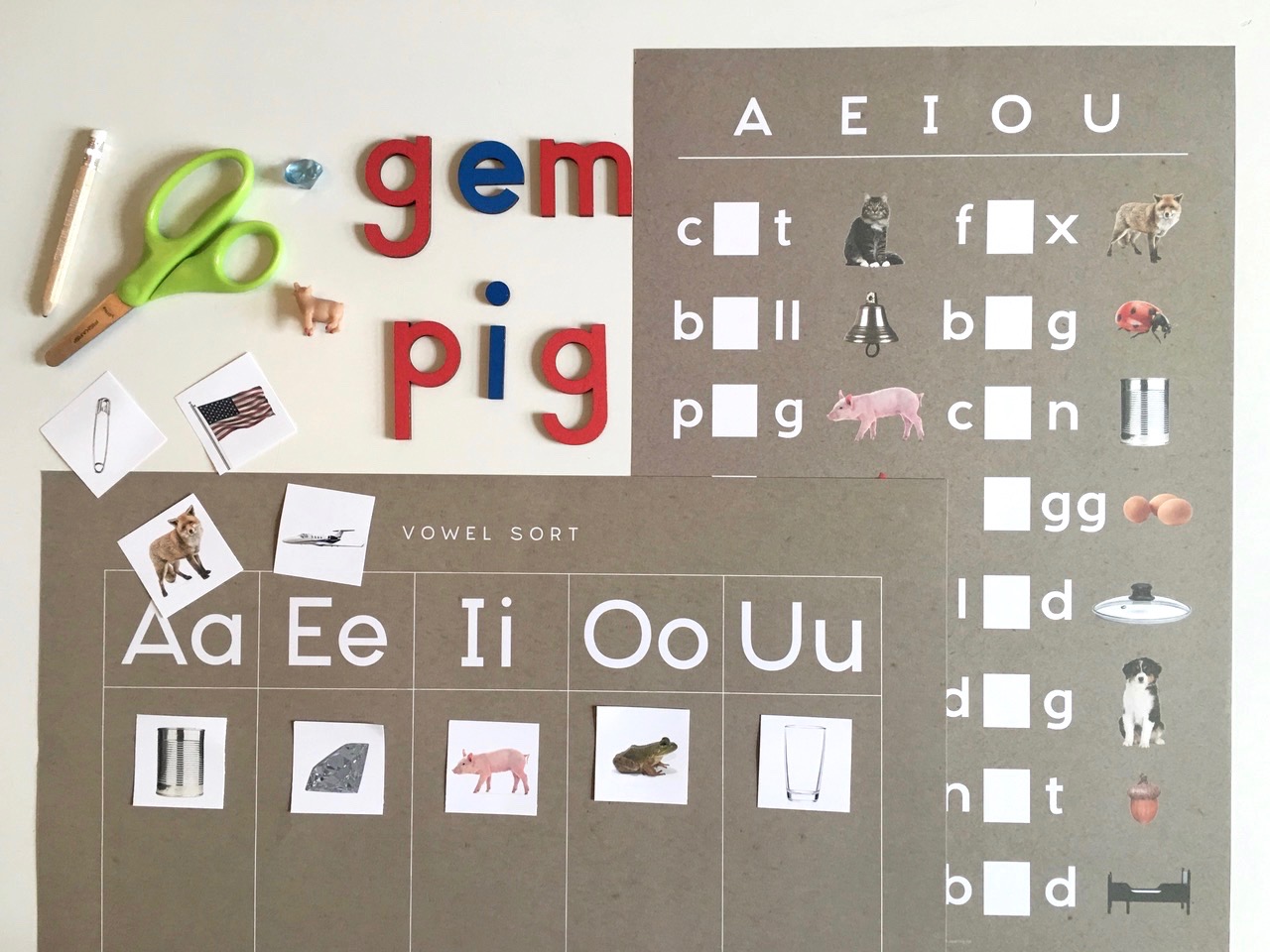
Description
Which short vowel do you hear? Some sounds are easier to hear than others, and short vowel sounds can be tricky for young learners! For instance, children often mix up the short /i/ and short /e/ sounds, because they sound so much alike in words. So it’s important to practice this skill over and over and over again.
Use our cut outs and sorting mats to help these pre-readers learn short vowel letter sounds. Early writers may want to sort the images and then practice writing the words phonetically on a dry erase board.
Vowel Sort All: jet, pig, gem, can, cup, flag, fox, pin, bug, frog
When you are finished with the vowel sort, you can follow up with our short vowel sound practice/assessment sheet!
Materials
- Printables
- Scissors
- Glue
- Optional: Dry Erase Board, Dry Erase Marker, Pencil
Books to Inspire
- Elmer by David McKee
- The Princess and the Pig by Jonathan Emmett
- The War Between the Vowels and Consonants by Priscilla Turner
Teaching Children Kindness
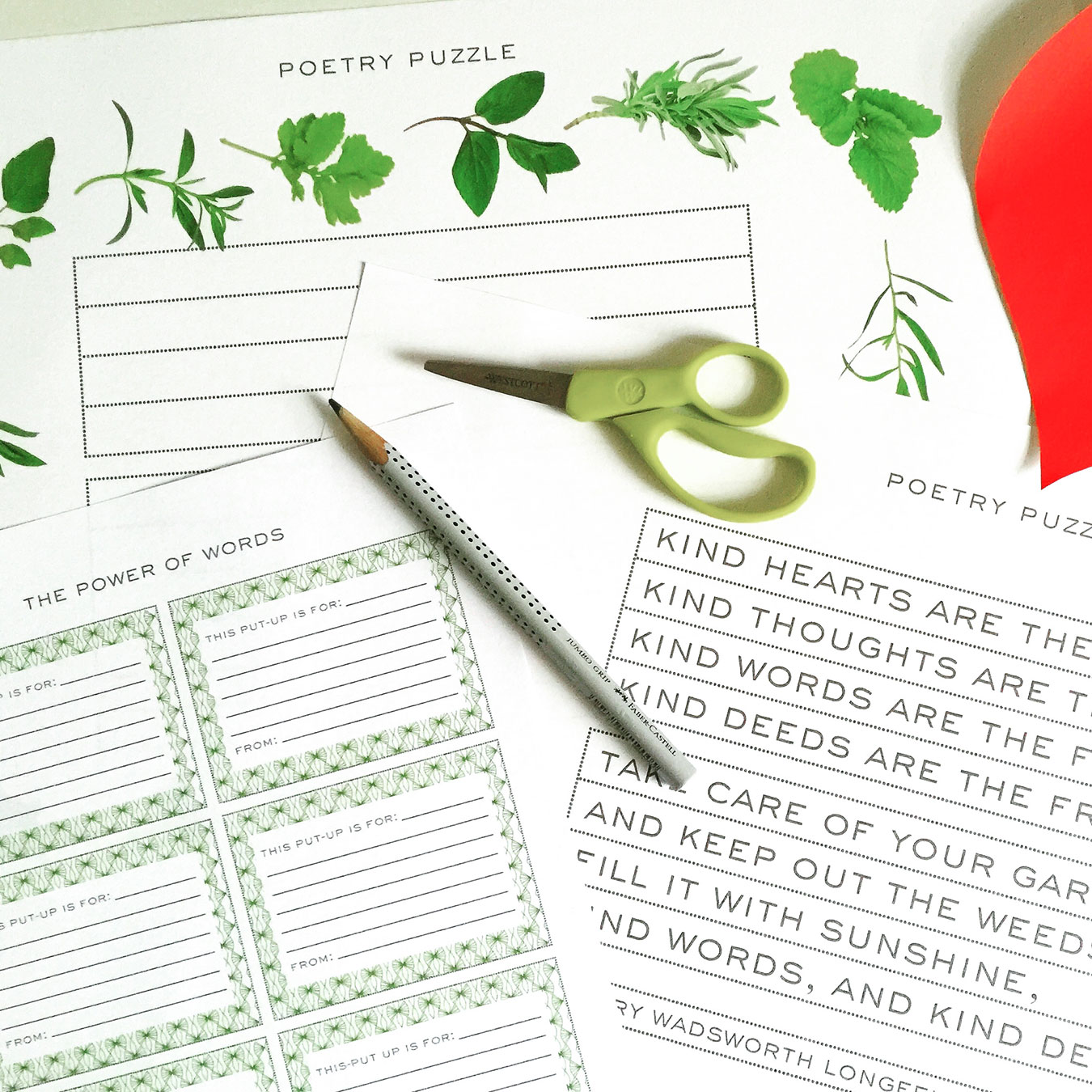
Description
If I could choose two phrases that would be introduced into every household and school across the land, it would be “put-ups” and “put-downs.” These are two of the most powerful concepts I have ever taught in the classroom or to my own children. Equipping young children with a deep understanding of these terms gives them the ability to communicate feelings, which may have seemed almost intangible before. The language of put-ups and put-downs provides children with the skills needed for them to speak up for themselves as well as to stand up for others.
Simply stated, “put-downs” are words or actions that make people feel bad, and “put-ups” are words or actions that make people feel good. It is a simple concept to teach, and the impact can be profound. Ask your child to brainstorm real-life examples of both put-ups and put-downs. Next, invite them to spread the kindness by using a put-up paper to write put-ups to friends and loved ones.
Once you have the concept of put-ups and put-downs, you enjoy our kindness poetry puzzle! Poetry is a wonderful way to explore a variety of different abstract concepts such as, kindness. In the lesson below, children will use the example of a poem by Henry Wadsworth Longfellow to see how he used nature as a metaphor for kindness. This poetry puzzle format offers so many opportunities for strengthening early literacy skills such as sequencing, letter and word recognition, and reading withe fluency and expression.
Materials
- Printables
- Pencil or Pens
- Scissors
- Glue
More to Explore
Begin to incorporate the words “put-ups” and “put-downs” into your daily conversations. Point out when you hear someone giving a put-down and brainstorm ways of saying the same thing differently so that it does not feel so negative. On the same note, point out the “put-ups” that you hear your children giving or receiving. You will be amazed at how quickly children begin to integrate this concept into their hearts and minds.
Books to Inspire
- One by Kathryn Otoshi
- Chrysanthemum by Kevin Henkes
- The 100 Dresses by Eleanor Estes
- How Full Is Your Bucket? For Kids by Tom Rath and Mary Reckmeyer
Volcano!
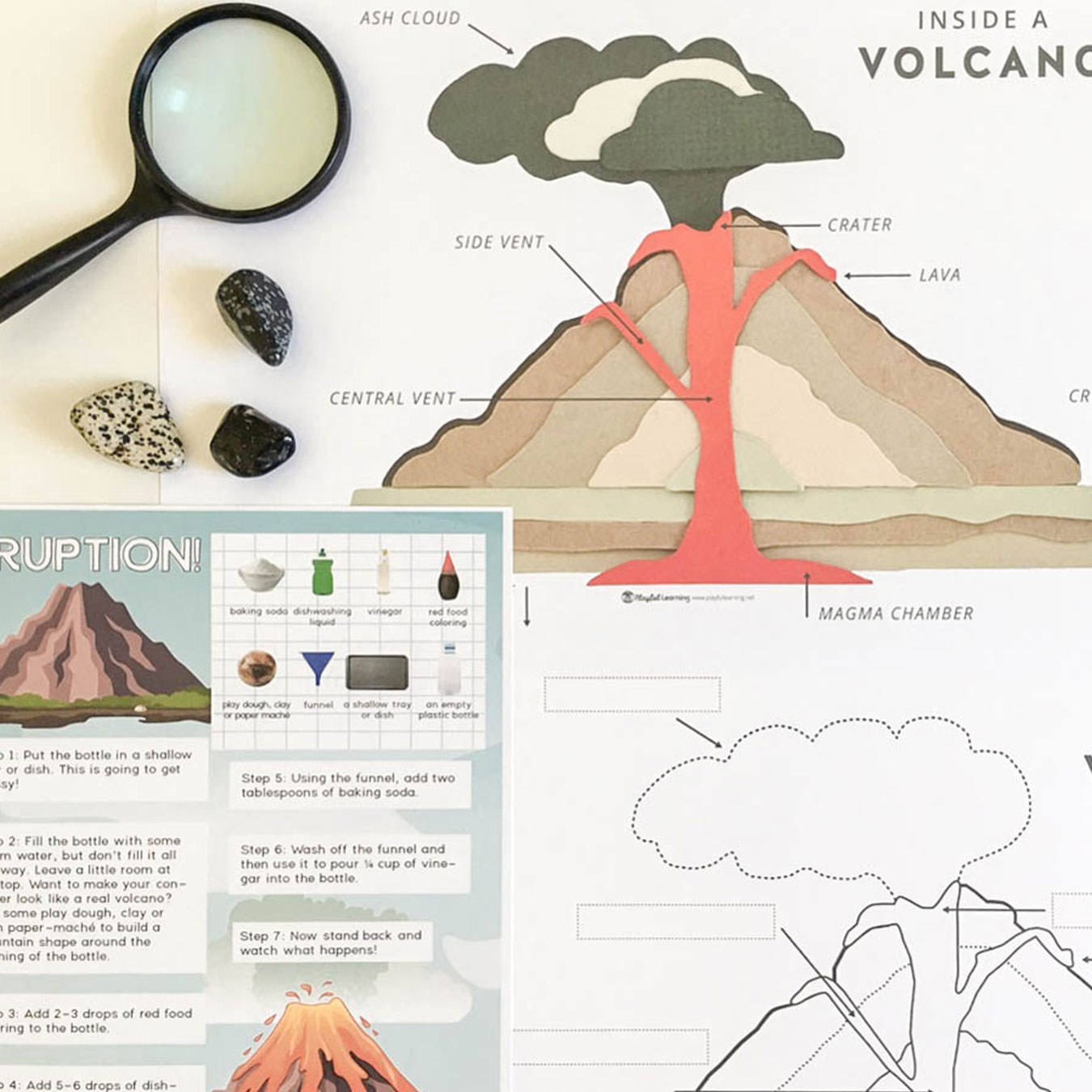
Description
Volcanos are one of those universal topics that captivate children young and old…
These lessons guide you and your child through the process of “exploding” a volcano and learning about how they work!
Do you know why a volcano erupts? Over thousands and thousands of years, the gas bubbles inside of magma (hot liquid rock) expand and cause pressure to build up. When that heat and pressure pushes on weak spots in the Earth’s surface, it is eventually forced up and expelled. This lesson demonstrates that idea. Adding vinegar to baking soda causes a chemical reaction which mimics the appearance of an actual volcano!
Once you have made a volcano erupt, it’s time to settle in and learn a bit more about how they work. The next activity includes vocabulary development, handwriting practice, and scientific discovery all rolled into one lesson! In this lesson, children identify the different parts of a volcano and learn about their functions. Label the parts of a volcano or use the printable as an invitation to build one out of play dough, clay, or paper mache. Junior volcanologists might even want to make an observational drawing or learn more about the different types of volcanoes. So hang up the diagram and put out a collection of resource books to give your scientist the freedom to explore and discover.
Here is some language to use as you explore the various parts of a volcano:
Mantle: The layer of the Earth between the crust and the outer core.
Crust: The outermost part of the Earth that is composed of rock.
Magma Chamber: The area below the earth’s crust from which magma flows out.
Central Vent: The main opening of a volcano where molten magma is released to the surface.
Side Vent: Smaller openings through which ash, gases, and lava escape.
Lava: Rock that is hot enough to be in liquid form and expelled during an eruption.
Crater: A small depression at the top of a volcano which has gotten blown off after an eruption.
Ash Cloud: Small pieces of rock, minerals, and volcanic glass that are discharged into the area during an eruption and then carried further by the wind.
Materials
- Printables
- Writing Tools
Books to Inspire
- Mountains and Volcanoes by Barbara Taylor
- Eye Wonder: Volcanoes by DK Publishing
- Volcanoes – Why Do They Happen? by Baby Professor
What Lives in the Ocean?
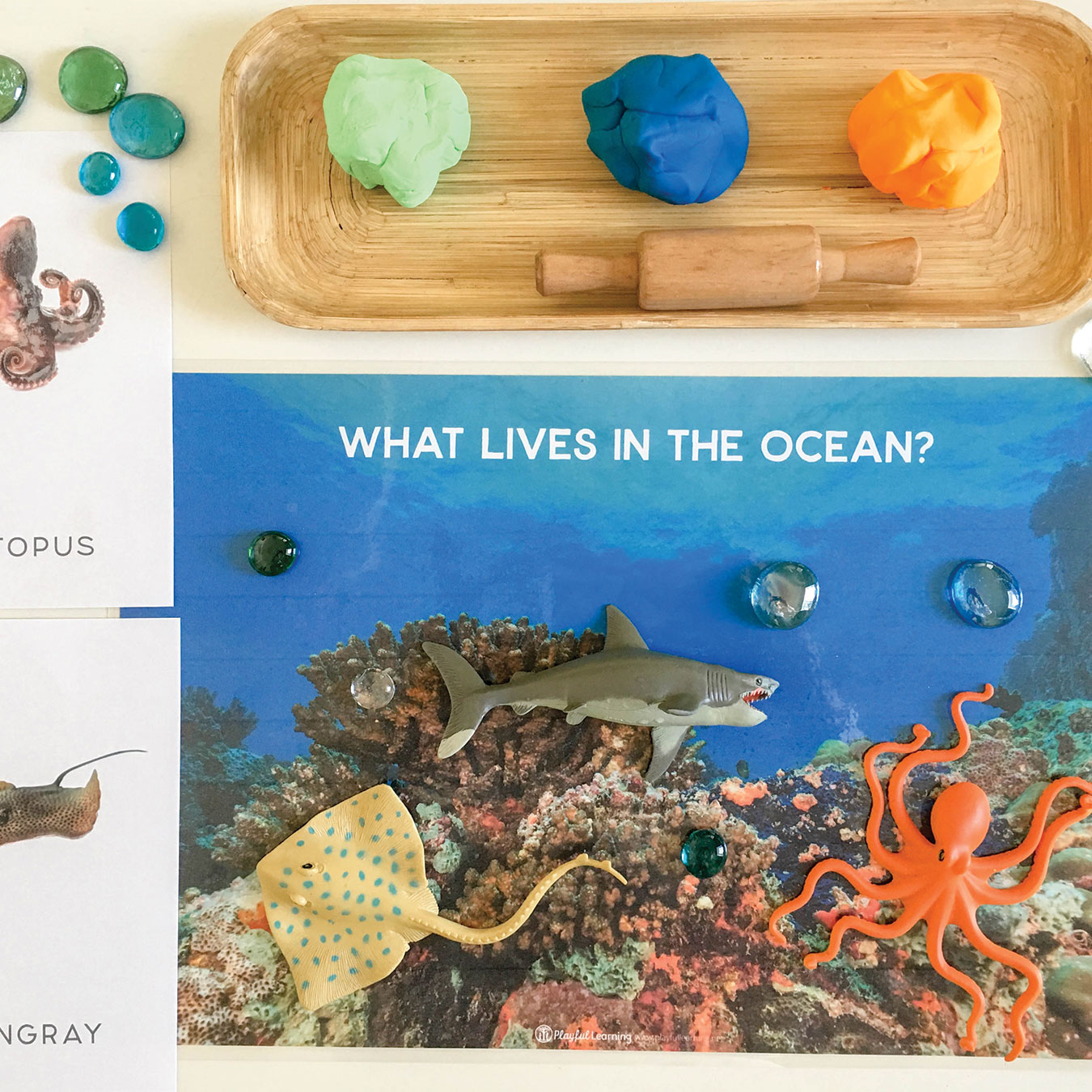
Description
Children are fascinated by sea life… Our oceans and bays are full of fascinating creatures that can captivate young minds. One way to explore sea life with young chidlren is through open-ended dramatic play!
Simply, laminate our play dough mat and put out a collection of small figures, shells and some fun play dough colors and have children create their own creatures from the deep.
A favorite in the Playful Learning Studio is to match toy ocean animals to those labeled on our three-part-cards. Three part cards are a classic Montessori tool, used to build vocabulary and aid children in learning new information about a topic. In this set, children explore different types of animals that live in the ocean. There are many ways to use these cards including playing memory, matching words to pictures, or playing a “Go Fish” style game.
Materials
- Printables
- Optional: Play Dough or Toy Figures like Ocean Animals, Coral Reef Set, Baby Sea Life, Sharks, Deep Sea Creatures
Books to Inspire
- In the Sea by David Elliott
- Little Explorers: Under the Sea by Little Bee Books
- Ocean: A Visual Encyclopedia by DK
- National Geographic Little Kids First Big Book of the Ocean by Catherine D. Hughes
- Ocean Animals from Head to Tail by Stacey Roderick
- Hidden World: Ocean by Libby Walden
Join us over at Teachers’ Lounge and enjoy or complete Sea Life unit!
Land, Sea, or Air?
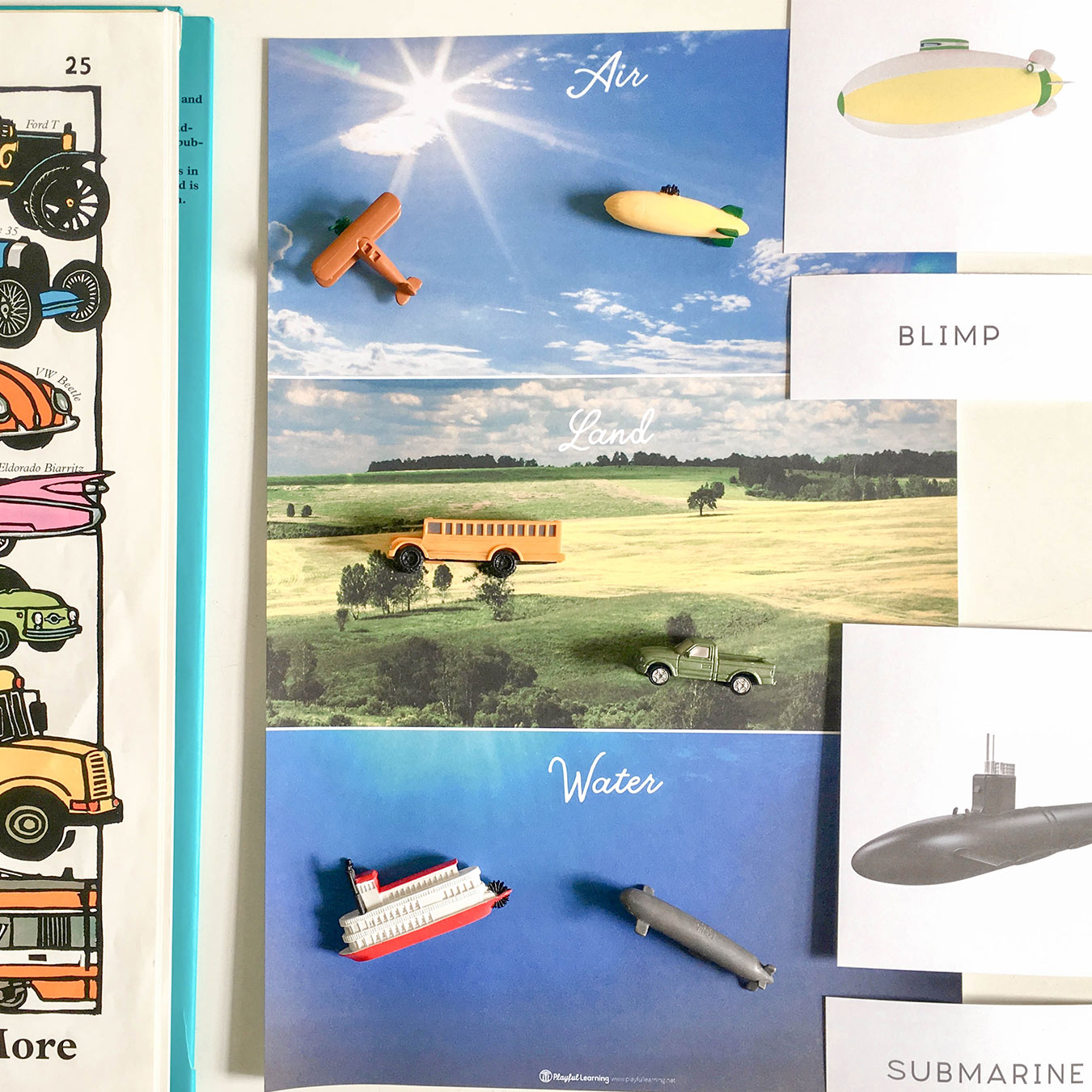
Description
Sorting and classifying objects not only helps children make sense of the natural world around them, but it is also an important mathematical and scientific inquiry skill. When children begin to learn about different modes of transportation and think about how people move from place to place, it is a wonderful opportunity to introduce three geographical terms (air, land, and water). Use this printable to sort vehicles into these three categories while also strengthening those cutting skills. In the Playful Learning studio, we also love to have a collection of small vehicles nearby, perfect for tiny hands, to name, sort and classify. You can also use our Transportation Three-Part Cards.
Materials
- Printables
- Scissors
- Glue
- Optional: Vehicles (On the Road, In the Sky, In the Water)
Books to Inspire
- Transportation by Gail Gibbons
- Cars and Trucks and Things That Go by Richard Scarry
- Transportation by Alain Gree
Join us over at Teachers’ Lounge and enjoy or complete Transportation unit!
Parts of a Flower
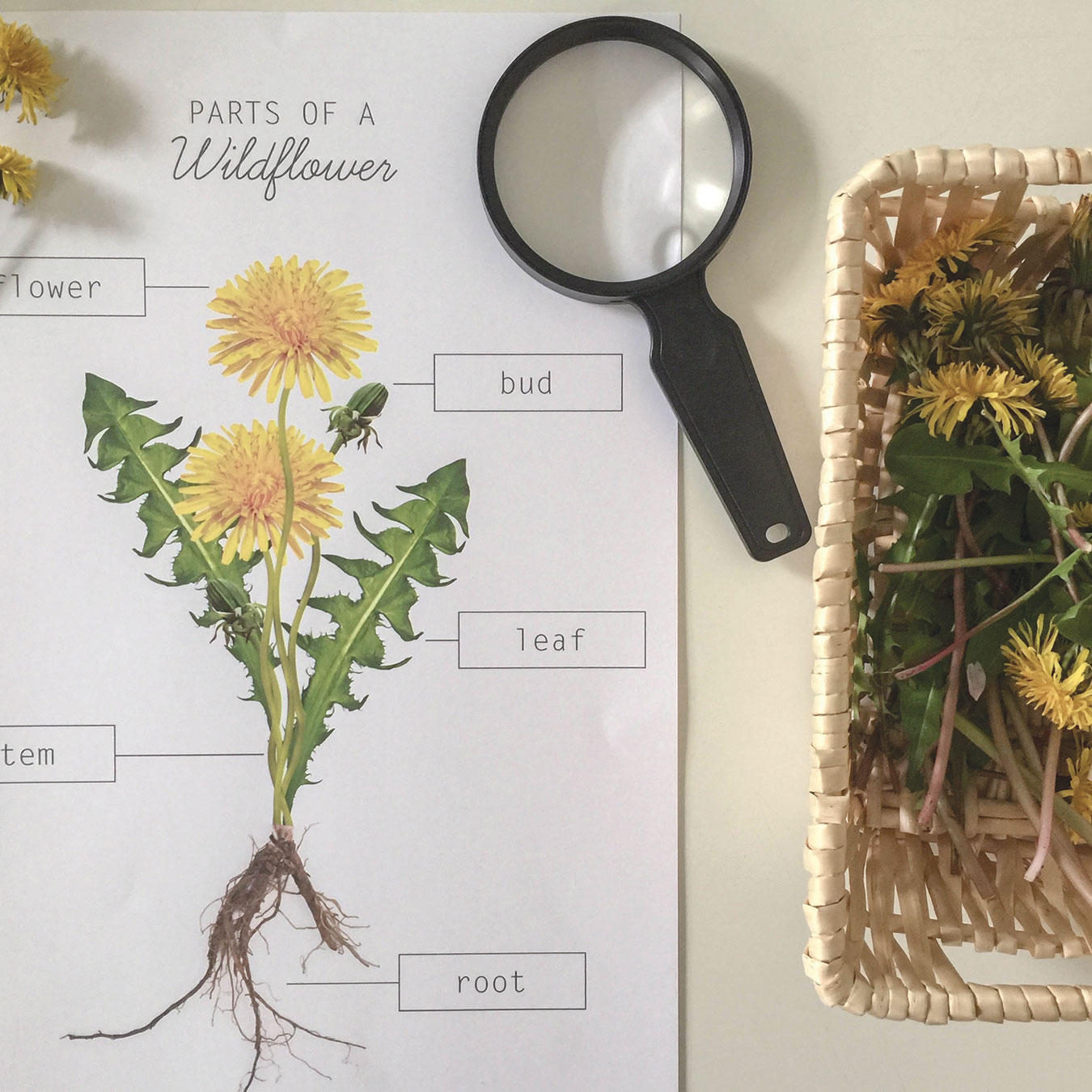
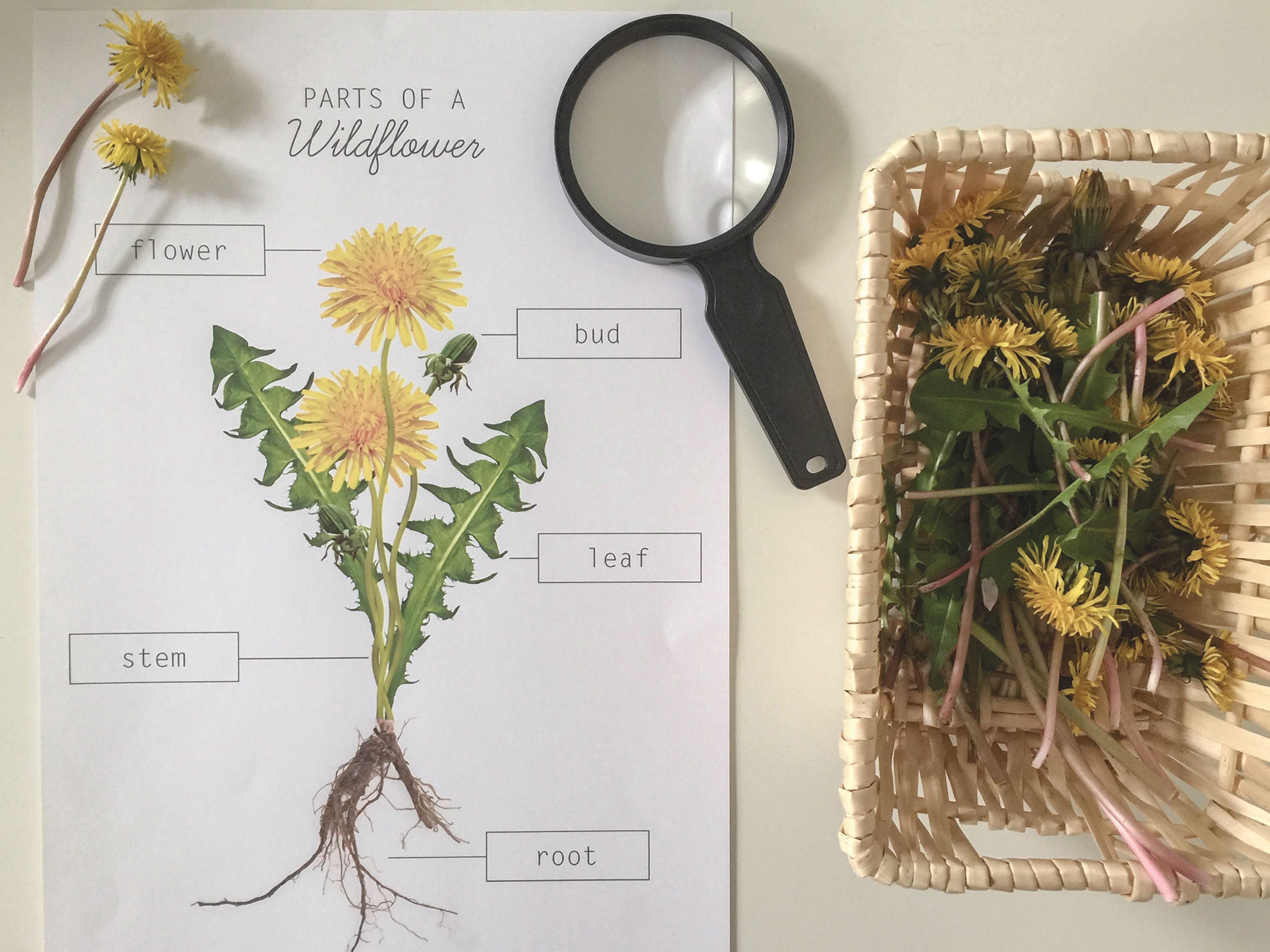
Description
Have you ever slowed down enough to notice a flower? To really examine and admire each tiny little part of these wild and beautiful bits of nature? Use our printable to learn about, and label, different parts of a flower. Laminate the blank printable, and use dry erase markers, so that it can be used over and over again.
Here is some language to use as you explore the various parts of a flower:
Root: Anchors the plant, absorbs water and minerals and stores extra food
Stem: Supports the leaves and flowers, carries water and minerals up from the roots to the leaves, and then takes food back down so that it can be shared with other parts of the plant
Leaf: Turns energy, from the sun, into food for the plant as well as breathe in carbon dioxide and breathe out oxygen
Bud: May develop into a flower, leaf, or shoot
Flower: Blossoms to produce the seed, or fruit, of the plant
Materials
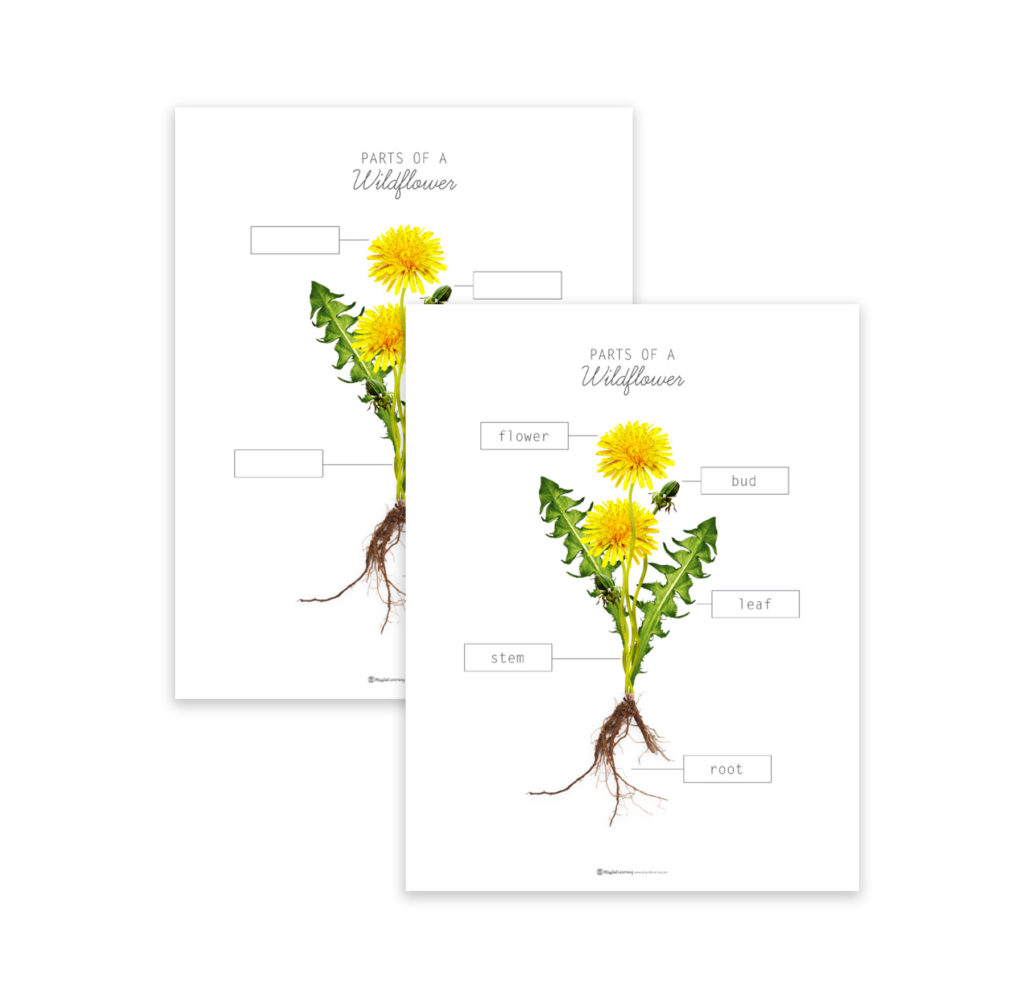
- Dandelions for dissecting
- Printables
- Pencil or Dry Erase Marker
- Optional: Magnifying Glass
Books to Inspire
- A Dandelion’s Life by John Himmelman
- Plants and Flowers by Sally Hewitt
- Botanicum: Welcome to the Museum by Kathy Willis
More to Explore
Join us over at Teachers’ Lounge and enjoy or complete Flower Unit!
SaveSave
My Seed Journal


Though I do not believe that a plant will spring up where no seed has been, I have great faith in a seed… Convince me that you have a seed there, and I am prepared to expect wonders. – Henry David Thoreau
Description
The best way to learn about seeds is to plant them, care for them, and then watch the magic unfold! Whether you plant your seed in a jar (filled with cotton balls), a small pot filled with soil, or in an outside garden, children will enjoy watering their seed and making predictions about what it might look like as it grows. Use our seed journal pages and put together a book to track the seed’s growth. We suggest observing your seed for about 12-16 days. Each day, your child can draw a picture, record observations, and measure the height of her plant. Keep our Parts of a Bean Seed printables nearby, along with a magnifying glass and a measuring tape, so that your child can label the parts of the seed and the plant as it grows. Don’t forget to try this out with different types of seeds! Which seeds germinate the fastest? Which seeds germinate the slowest?
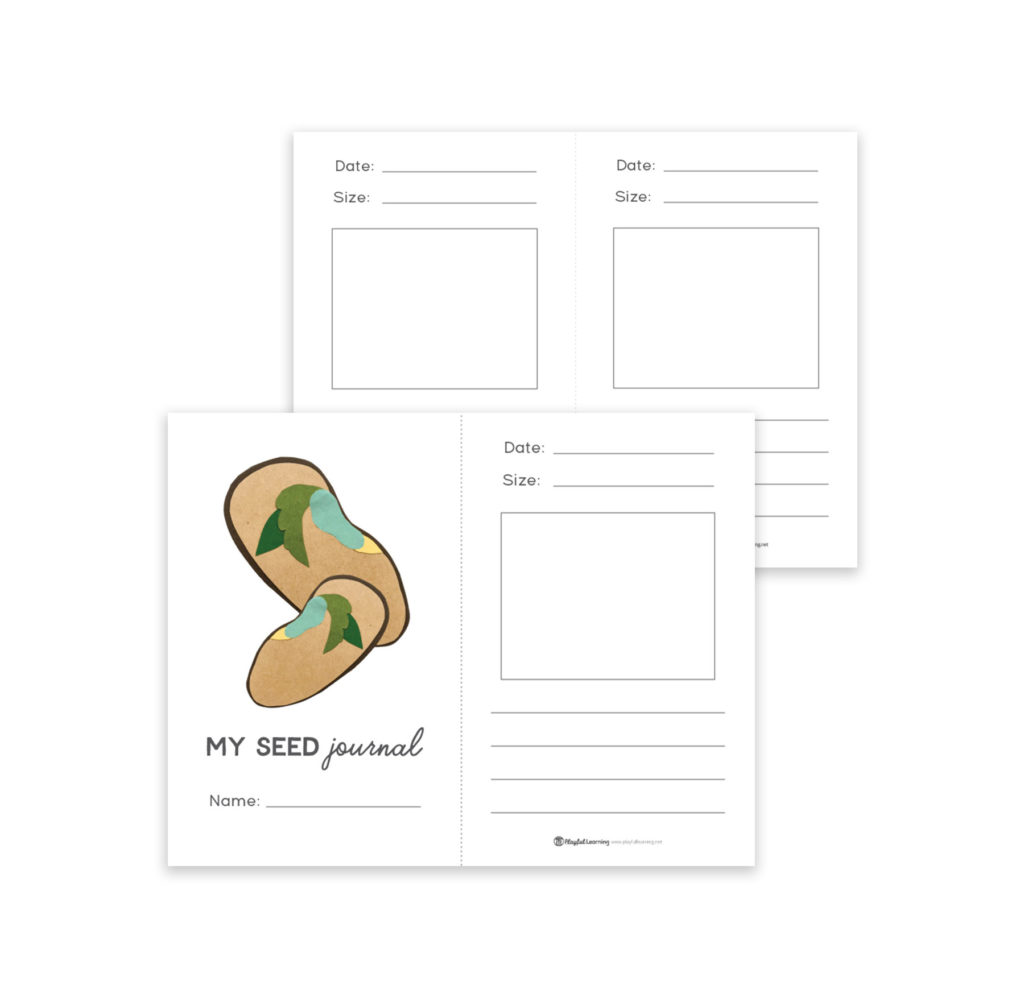
Materials
- Printables
- My Seed Journal (2 lines) 1, 2
- My Seed Journal (4 lines) 1, 2
- Parts of a Bean Seed
- Seeds (Sunflower, Lima Beans, Peas, Corn)
- Jars (filled with damp paper towels) or Small Pots (filled with soil)
- Spray Bottle for Water
- Pencil
- Ruler or Measuring Tape
- Your Favorite Art Materials
- Optional: Magnifying Glass
Books to Inspire
- How a Seed Grows by Helene J. Jordan
- Gardening Lab for Kids: 52 Fun Experiments to Learn, Grow, Harvest, Make, Play and Enjoy Your Garden by Renata Brown
- The Lorax by Dr. Seuss
Join us over at Teachers’ Lounge and enjoy or complete Seed Unit!
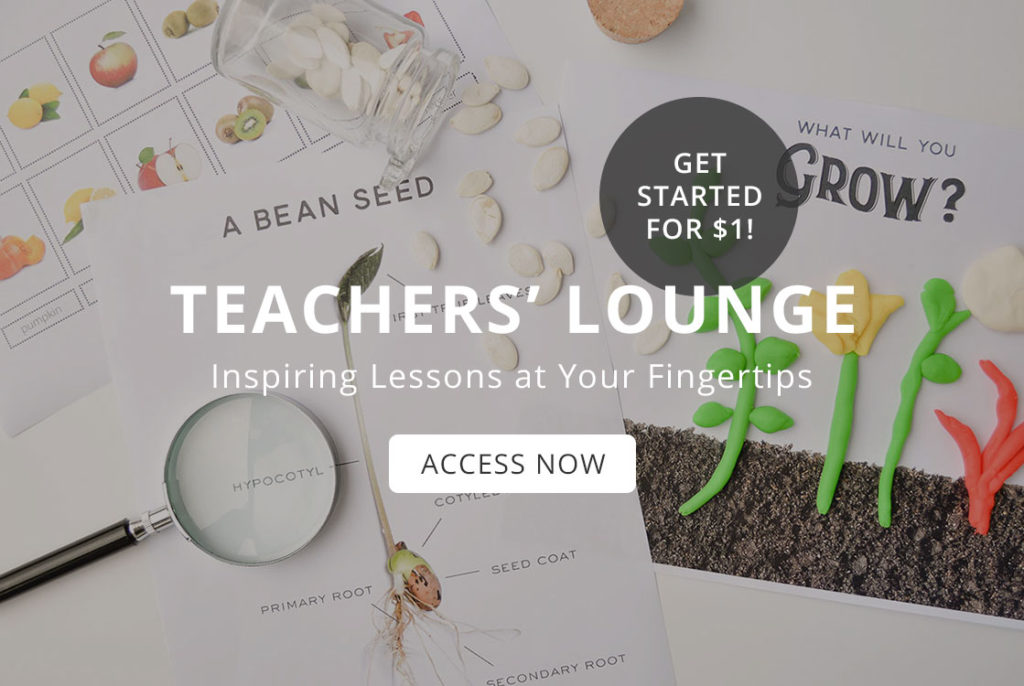
DIY Comics

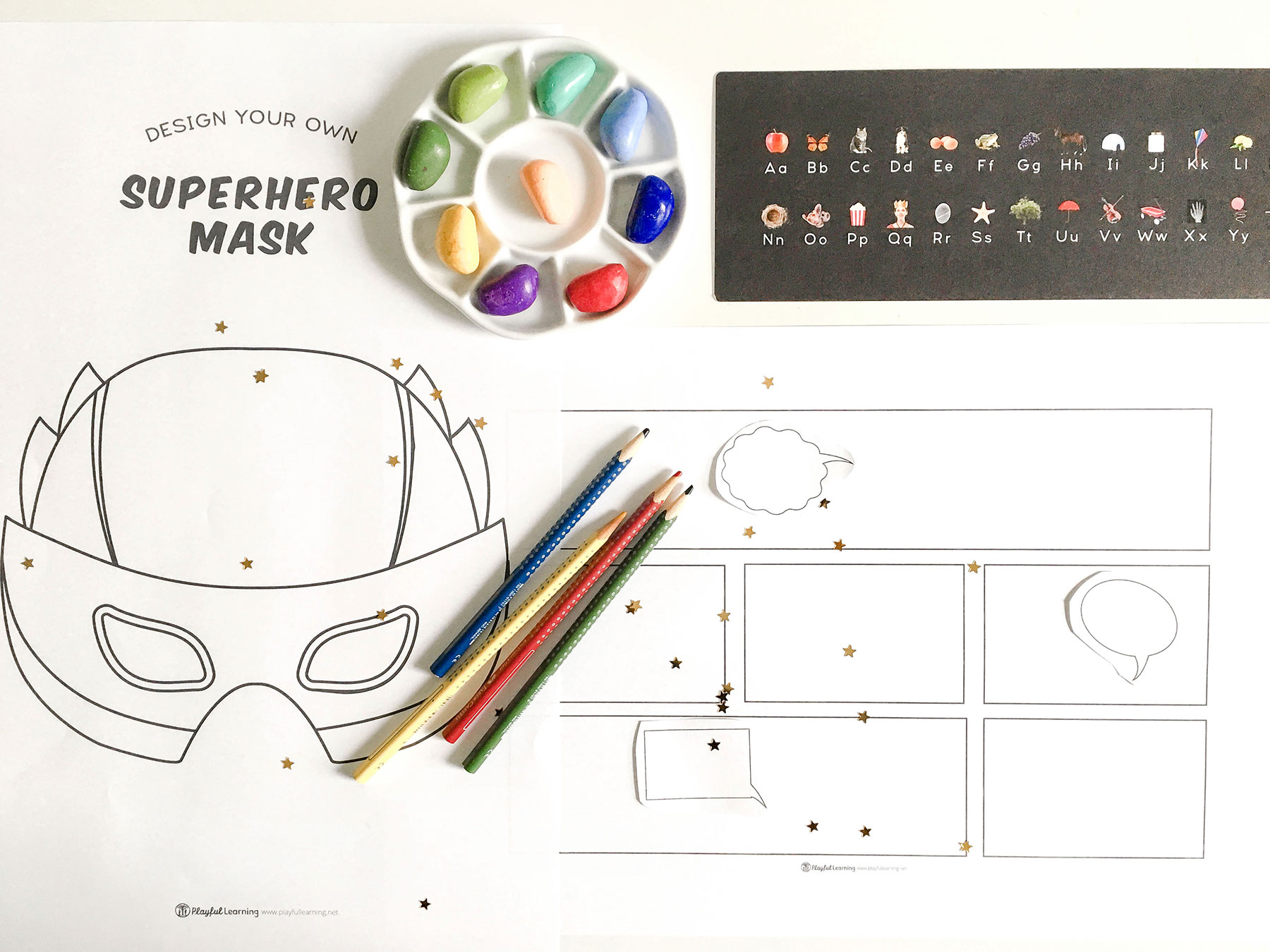
Description
Comic strips are a wonderful way for children to tell complex stories within a simple framework. Use our DIY comic printables to practice writing in a creative and fun way! Gather some examples of comic strips, from newspapers, books, or online, and put them out for inspiration. Explain to the children how we read the boxes from left to right and how speech bubbles are used to show that a character is talking (or thinking about something).
Encourage your comic writers to tell their story in pictures first, and then go back and add speech bubbles where appropriate. Children can cut apart the speech bubbles and glue them directly onto the comic! Remind them that not every box needs dialogue. Much of a comic’s storyline come from the illustrations, which is why comics are so accessible to younger writers, so talk about making the pictures detailed enough so that readers can interpret the story without too many words.
Tap into your inner superpowers and write one along with your children or students…
Materials
- Printables
- Thought Bubbles
- Speech Bubbles
- Comic Strip (title)
- Comic Strip (no title)
- Hero Mask (for added drama)
- Pencils
- Scissors
- Glue
- Your Favorite Art Materials
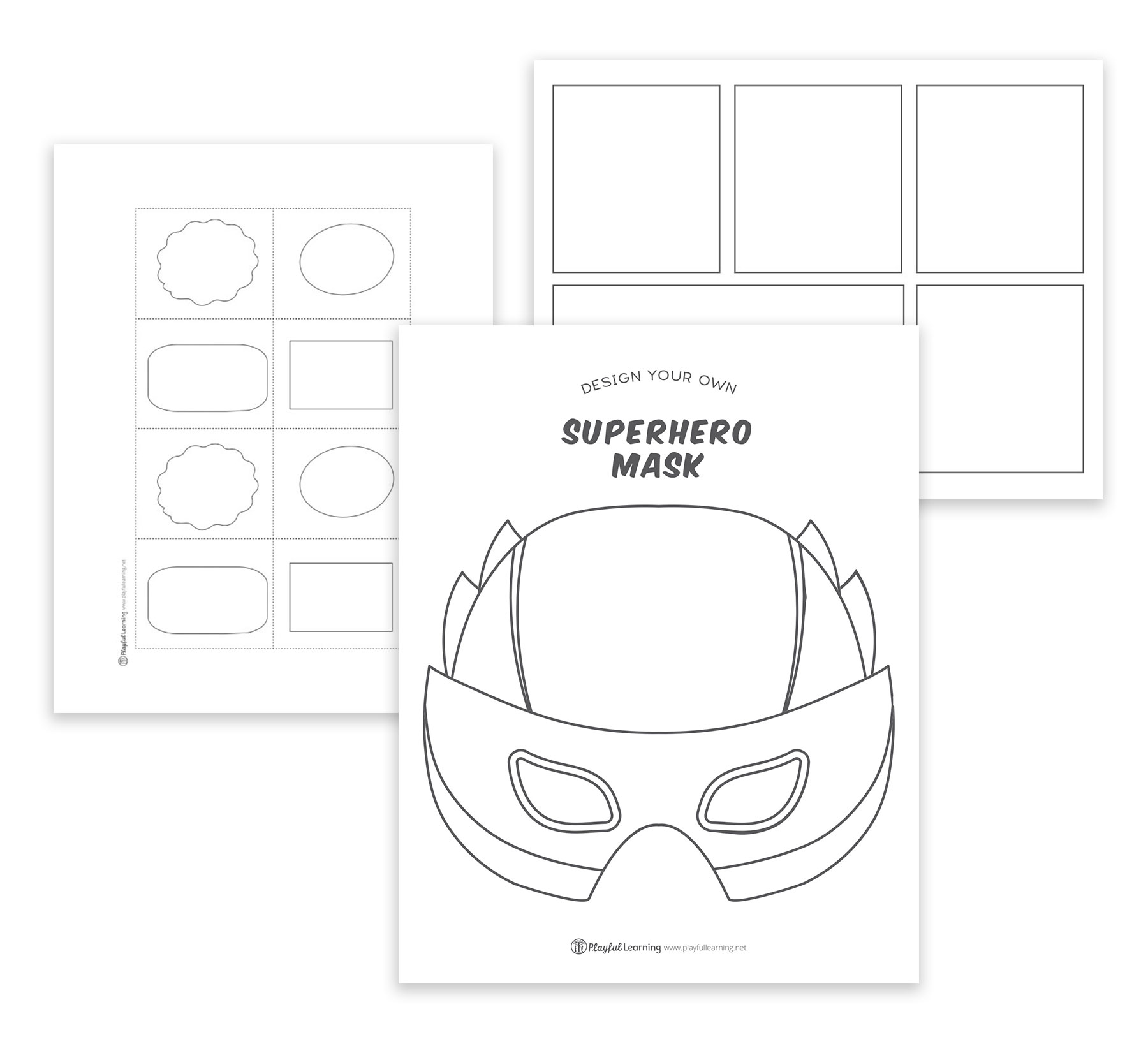
Books to Inspire
- Nursery Rhyme Comics: 50 Timeless Rhymes from 50 Celebrated Cartoonists by Chris Duffy
- Kapow! by George O’Connor
- Traction Man Is Here! by Mini Grey
Join us over at the Teachers’ Lounge and enjoy access to our complete unit on Superheroes!
Sewing Snowflakes

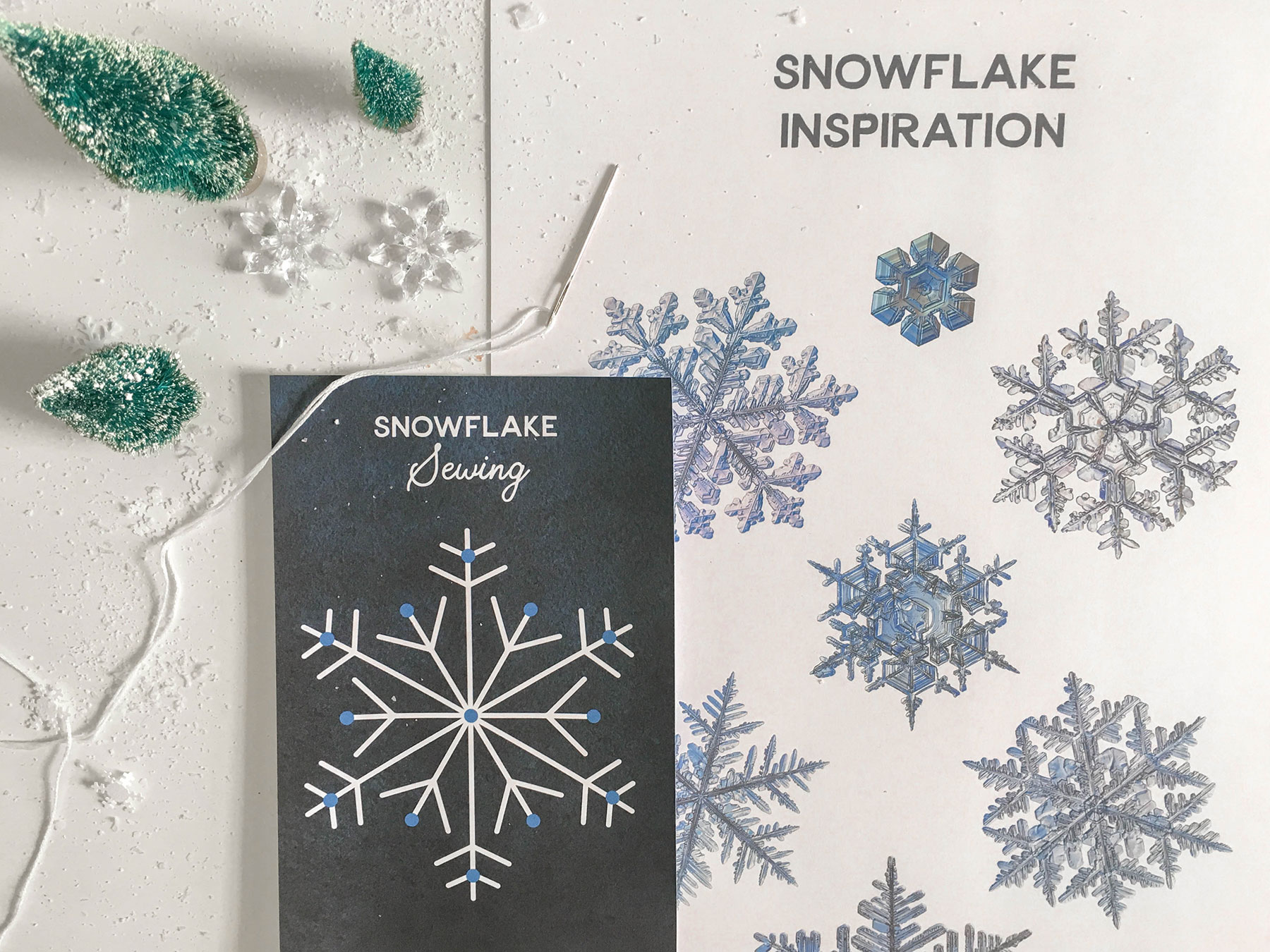
Description
‘Tis the season to celebrate snow! This hands-on activity encourages children to slow down and look at the details in snowflakes, while practicing their fine motor skills. Before presenting the cards to your child we suggest cutting each page in half and printing them out on cardstock, or on paper and laminating them. Then use a nail to poke holes in the blue dots. You may also want to look at photographs of snowflakes and have your child explore and trace the lines. When you’re ready, present your child with the prepared cards along with a threaded embroidery needle.
Next, enjoy the time sewing and chatting with your little scientists…

Materials
- Printables
- Card stock for printing
- Embroidery needle
- Embroidery floss
- Nail
Books to Inspire
- The Secret Life of a Snowflake by Kenneth Libbrecht
- Snowflakes by Cerrie Burnell
- Snow by Cynthia Rylant
Join us over at Teachers’ Lounge and enjoy or complete Winter Weather Unit!
